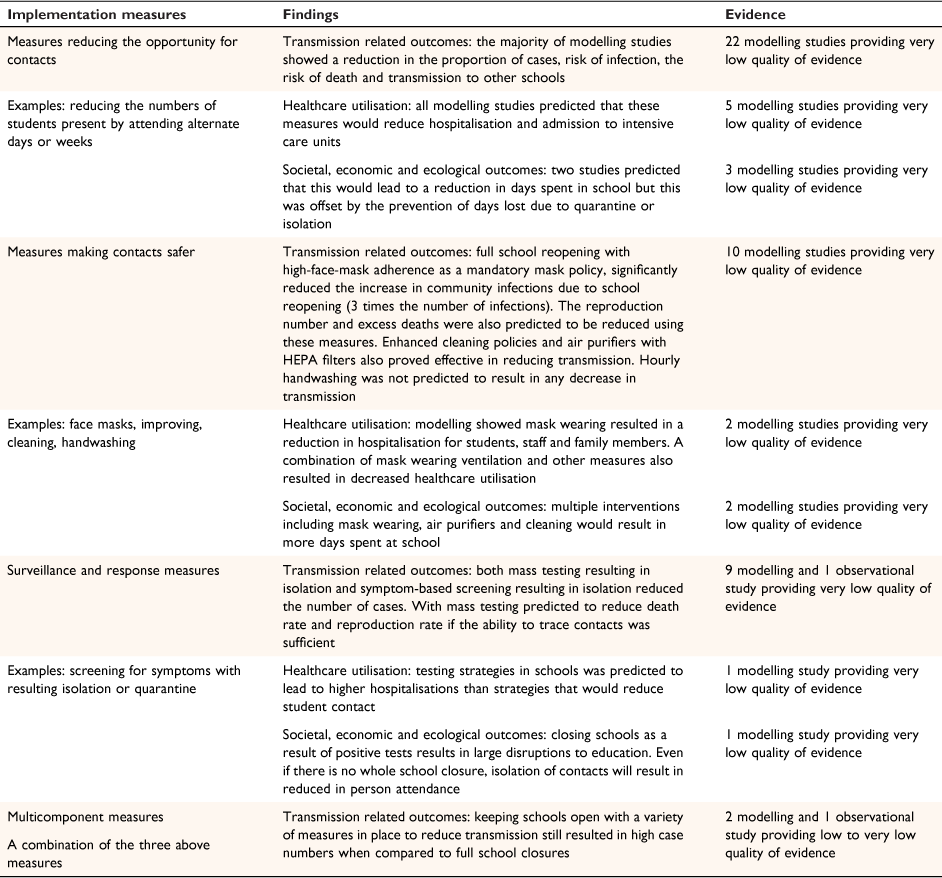Coronavirus (COVID-19): measures implemented in the school setting to contain the COVID‐19 pandemic
Vanessa Jordan 1 *1 Assoc. Professor, University of Auckland, Auckland, New Zealand.
Journal of Primary Health Care 14(1) 87-88 https://doi.org/10.1071/HC19569
Published: 13 April 2022
© 2022 The Author(s) (or their employer(s)). Published by CSIRO Publishing on behalf of The Royal New Zealand College of General Practitioners. This is an open access article distributed under the Creative Commons Attribution 4.0 International License (CC BY).
Cochrane Review: Krishnaratne S, Littlecott H, Sell K, Burns J, Rabe JE, Stratil JM, Litwin T, Kreutz C, Coenen M, Geffert K, Boger AH, Movsisyan A, Kratzer S, Klinger C, Wabnitz K, Strahwald B, Verboom B, Rehfuess E, Biallas RL, Jung-Sievers C, Voss S, Pfadenhauer LM. Measures implemented in the school setting to contain the COVID-19 pandemic. Cochrane Database of Systematic Reviews 2022, Issue 1. Art. No. CD015029. 10.1002/14651858.CD015029.1
Background
On the 11th of March 2020 the World Health Organisation (WHO) declared the novel coronavirus (COVID-19) outbreak a global pandemic.2 We have just passed the 100th week of education disruption across the globe. Worldwide over 151 countries have had national school closures.3 In New Zealand we have over a million affected learners.3 There are concerns that COVID-19 and the associated control measures such as school closures will negatively impact on children’s health and well-being.4 It is therefore important to measure the impact and effectiveness of the measures implemented during the COVID-19 pandemic.
Clinical bottom line
Reducing opportunities for contact within the school setting was shown to reduce transmission, hospitalisations, and death in multiple modelling studies. Although this reduced contact, which was achieved by reducing the number of students on campus, led to a reduction in the number of days spent in school this was offset by the number of days students would have lost due to quarantine as a result of higher case numbers. Wearing masks, improved ventilation and cleaning regimes also reduces transmission and reduced healthcare utilisation. These measures resulted in more days of school attendance overall. Testing and surveillance without reduction in contact in a school led to a high number of hospitalisations and larger disruptions to education (Table 1).1

|
References
[1] Krishnaratne S, Littlecott H, Sell K. Measures implemented in the school setting to contain the COVID‐19 pandemic. Cochrane Database Syst Rev. 2022; 1 CD015029| Measures implemented in the school setting to contain the COVID‐19 pandemic.Crossref | GoogleScholarGoogle Scholar | 35037252PubMed |
[2] World Health Organization. WHO Director-General’s opening remarks at the media briefing on COVID-19. 11 March 2020.
[3] UNESCO. Education: from disruption to recovery. 2022. Available at https://en.unesco.org/covid19/educationresponse [Accessed 1 March 2022]
[4] Golberstein E, Wen H, Miller BF. Coronavirus Disease 2019 (COVID-19) and mental health for children and adolescents. JAMA Pediatr. 2020; 174 819–820.
| Coronavirus Disease 2019 (COVID-19) and mental health for children and adolescents.Crossref | GoogleScholarGoogle Scholar | 32286618PubMed |


